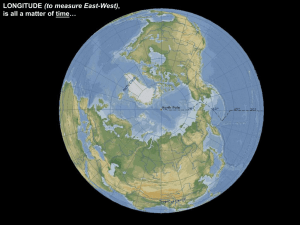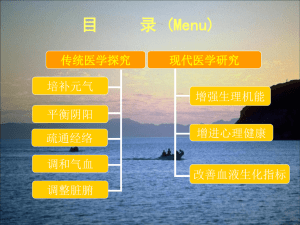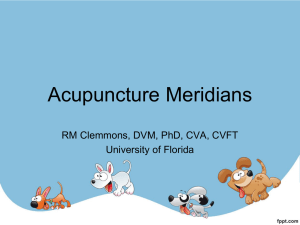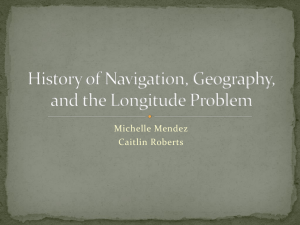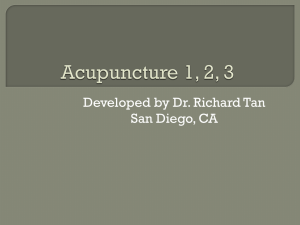meridians and collaterals
advertisement
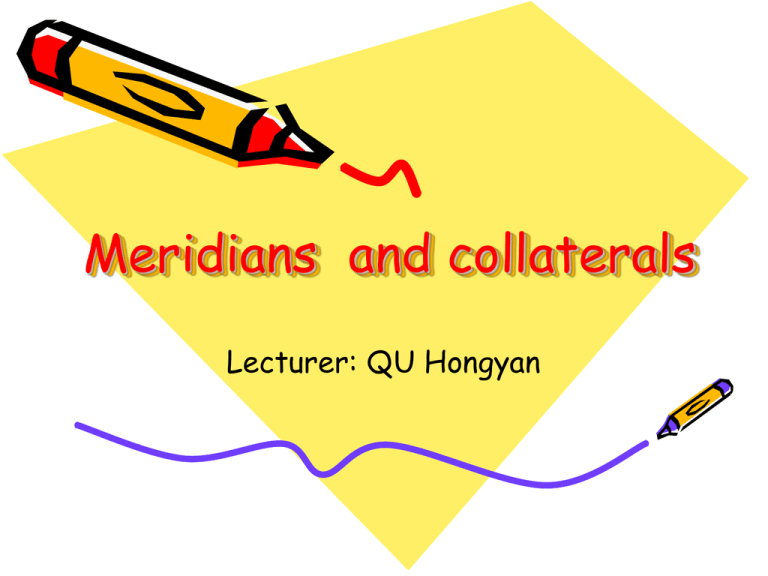
Meridians and collaterals Lecturer: QU Hongyan Contents A General Introduction to the Meridians and Collaterals A general introduction to the twelve regular meridians Basic functions, circulation routes and function features of eight extra meridians Meridians and collaterals Meridians and collaterals or “Jing Luo” in Chinese, are pathways that transport qi and blood, and connect the internal zang-fu organs with the surface and other part of the body. trunk Jing, meridians, means “go through” or “a path”. They are strong and large. They run longitudinally and interiorly within the body. branches Luo, that is collaterals, means “something that connects” or “a net”. They are the branches of the meridians, thin and small. They run transversely and superficially, and crisscross and net the whole body. Twelve regular meridians Meridians Meridian Eight extra meridians system Twelve divergent meridians Collaterals Fifteen connecting collaterals Superficial collaterals Tertiary collaterals Physiological functions of meridians Communicating the exterior with the interior, connecting with viscera Circulating qi and blood and coordinating yin and yang Resisting evil qi and manifesting symptoms and signs of diseases Transmitting sensation and regulating the deficiency and excess Twelve regular meridians The nomenclature of the twelve regular meridians is based on three factors, which are hand or foot, yin or yang, and zang or fu organs. e.g. Lung meridian of hand-taiyin Large intestine meridian of hand-yangming Gallbladder meridian of foot-shaoyang Flowing orders of Twelve Regular Meridians Three yin meridians of hand Chest or Abdomen Lung meridian of hand taiyin Pericardium meridian of hand jueyi Heart meridian of hand shaoyin Three yin meridians of foot Spleen meridian of foot taiyin Liver meridian of foot jueyi Kidney meridian of foot shaoyin Hand Three yang meridians of hand Larege intestine meridian of hand yangming Sanjiao meridian of hand shaoyang Small intestine meridian of hand taiyang Foot Head Three yang meridians of foot Stomach meridian of foot yangming Gallbladder meridian of foot shaoyang Bladder meridian of foot taiyang Head three yang meridian of hand Chest three yin meridian of hand three yang meridian Abdomen of foot three yin meridian of foot Hand Foot Directions of twelve regular meridians • Three yin meridians of hand run from chest to hand • Three yang meridians of hand run from hand to head • Three yang meridians of foot run from head to foot • Three yin meridians of foot run from foot to abdomen and chest. If we extend our arms overhead, the yin meridians run upward while yang ones run downward Distribution of the twelve regular meridians • The Twelve Regular Meridians have lateral and symmetrical distribution on the head, face, trunk and limbs. • The six yin meridians are distributed on the medial side of the limbs and on the chest and abdomen. • The six yang meridians are distributed on the lateral side of the limbs and on the head, face and trunk. Tip of great toe Externa l canthu s Tip of ring finger Liver Lung Tip of index finger Large Intestine Gallbladder Sanjiao Stomach Tip of great toe Chest Spleen Pericardium In the chest Kidney Tip of small toe Beside the nose Bladder Inner canthus Small Intestine Heart In the chest Tip of small finger Connections Yin meridians and yang meridians connect in the hand or the foot. Two yang meridians with the same name connect in the head or facial region. Hand yin meridians and foot yin meridians connect in the chest. Exterior-interior relationship Yin meridians, which are considered relatively inner, belong to zang organs and interact with fu organs. Yang meridians, which run relatively superficially, belong to fu organs and connect to zang organs. i.e. The heart meridian belongs to the heart and connect to the small intestine The small intestine meridian belongs to the small intestine and interact with the heart. Lung meridian of hand-taiyin Large intestine meridian of hand-yangming Stomach meridian of foot-yangming Spleen meridian of foot-taiyin Heart meridian of hand-shaoyin Small intestine meridian of hand-taiyang Bladder meridian of foot-taiyang Kidney meridian of foot-shaoyin Pericardium meridian of hand-jueyin Triple energizer meridian of hand-shaoyang Gallbladder meridian of foot-shaoyang Liver meridian of foot-jueyin The Eight Extra Meridians The Eight Extra Meridians are the meridians whose courses are different from the twelve regular meridians, eight in all, namely Governor Vessel, Conception Vessel, Thoroughfare Vessel, Belt Vessel, Yin Link Vessel, Yang Link Vessel, Yin Heel Vessel and Yang Heel Vessel. Differences compared with twelve regular meridians They do not belong to any zang-fu organs directly; They have no exterior-interior relationship amongst themselves They travel in an extraordinary way compared to the twelve regular meridians Apart from GV and CV which have their own points, the other meridians share the points with the twelve regular meridians. Functions of the Eight Extra Meridians • They distributed longitudinally and horizontally among the twelve regular meridians, working not only as strengthening the association between the twelve regular meridians, but also as dominating and controlling qi and blood, as well as balancing yin and yang. • They regulate the qi and blood of the regular meridians, such as in storage, drainage of the qi and blood. • If the twelve regular meridians were likened to the rivers and great rivers, the eight extraordinary meridians would be likened to the lakes and reserviors. Physiological functions : ( 1 ) regulates qi and blood of yang meridians and be named as sea of yang meridians ; ( 2 ) reflects the function of brain, kidney and spinal cord; (3) governs reproduction Governor Vessel Physiological functions: (1)regulates qi and blood of yin meridians and be named as sea of yin meridians; ( 2 ) regulates menstruation and pregnant fetus. Conception Vessel Conception Vessel governs uterus and gestation Physiological functions: ( 1 ) regulates qi and blood of twelve regular meridians; (2) governs reproduction; “the sea of twelve regular meridians” Thoroughfare Vessels “the sea of five zang organs and six fu organs” Physiological functions: restrains the other meridians like a belt Belt Vessel

